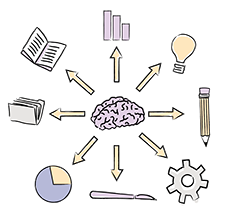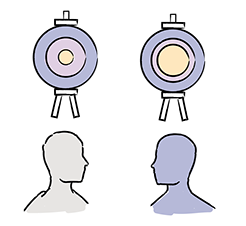As AO faculty members in your various roles, you will have likely come across the subject of instructional design. We will share with you some qualities of an instructional designer, allowing you to create educational activities based on your learners’ needs.
“Most curricula are unfocused ... There is a notable absence of structure and coherence” (Gardiner, 1996).
One of the program goals of the AO Foundation’s Chairperson Education Program ![]() , also referred to as CEP, is for participants to be able to base their instructional design on problem identification, needs assessment, target learners, learning objectives, educational methods, evaluation, and feedback.
, also referred to as CEP, is for participants to be able to base their instructional design on problem identification, needs assessment, target learners, learning objectives, educational methods, evaluation, and feedback.
what to focus on for your instructional design
10 tips on


Consider integrating the following when designing your educational activity:
 1.
1.
Connect with your learners’ needs (your audience) on an emotional level.
 2.
2.
Put yourself in the shoes of your learners.
 3.
3.
Conceptually and intuitively understand how people learn.
 4.
4.
Be an advocate for your learners.
 5.
5.
Brainstorm creative and innovative instructional strategies.
 6.
6.
Visualize instructional graphics, interactions, and the finished educational product.
 7.
7.
Write effective instructional text (audio, video, and any other scripts).
 8.
8.
Write well-defined learning objectives based on the learner’s needs.
 9.
9.
Identify and select appropriate teaching methods (knowledge, skills and attitudes).
 10.
10.
Create your educational activity curriculum based on the concepts of continuity, sequence, and integration (CSI).
- Ensure continuity in your curriculum.
- Sequence the teaching methods in your curriculum appropriately.
- Integrate the teaching methods in your curriculum appropriately.

C: Continuity—provides the opportunity to revisit knowledge and skills in more depth as they progress through an activity.
S: Sequence—the order in which things occur: from simple to complex, from known to unknown, completing pre-requisites required.
I: Integration—linking of information to enable learners to develop a holistic overview, and apply it to practice.
References
Gardiner, 1996 (cited in Diamond, RM (1998) Designing and Assessing Courses and Curricula: A practical guide. San Francisco: Jossey-Bass.
Geraldine O’Neill: Programme Design. Coherence, Sequence, and Integration in a Programme. UCD Teaching and Learning (www.ucd.ie/teaching). ![]()
Kern DE, Thomas P., Hughes M., Curriculum Development for Medical Education: A Six-Step Approach. The Johns Hopkins University Press, 2009.
Moore E, Green J, Gallis H., Achieving Desired Results and Improved Outcomes: Integrating Planning and Assessment Throughout Learning Activities. JOURNAL OF CONTINUING EDUCATION IN THE HEALTH PROFESSIONS—29(1), 2009 15.
FacultyFocus 2-2018
AO Foundation
FacultyFocus
2-2018
AO Foundation
Copyright © 2018 AO Foundation.
All rights reserved.